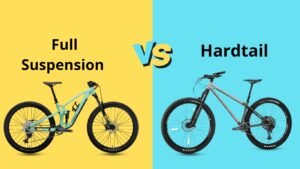Choosing a mountain bike is one of the most confusing parts because various types of bikes are available in the market, such as full suspension and a hardtail mountain bike, which we’ll discuss.
These bikes have unique pros and cons, although they are both good for different types of riders.
So, If you are a beginner or an experienced rider who just wants to buy or upgrade a mountain bike, you need to understand all these things about these bikes before you pick one for yourself.
Let’s learn all the advantages, disadvantages, and pros and cons of these bikes.
So, after reading this post completely, you will have an idea of which bike is right for you: the Hardtail or the full-suspension mountain bike.
Also read: Flat Pedals vs Clipless Pedals, which is best?
What Is a Full-Suspension Mountain Bike?

A full-suspension mountain bike is a trail bike that has a suspension system on both sides, front and rear.
This full-suspension system makes the rider feel more comfortable, plus this bike is easy to control on rough terrain.
The rear suspension is designed to absorb impacts, so you can ride it comfortably on rocky trails and roots, perform many mountain biking skills like bunny hopping, and tackle many other obstacles.
This type of full-suspension bike is suitable for technical trails and especially for downhill riding.
Pros:
Better Shock Absorption: It is very smooth on rough trails, reduces fatigue, and provides a better riding experience.
Increased Traction: This bike always keeps both wheels on the ground, which improves control and stability, which is important on decent and uneven trails.
Versatile: A full-suspension bike can perform on various types of terrain, such as steep descents, technical trails, and even cross-country roads.
Cons:
Higher Cost: The full suspension bike is expensive because it comes with more components and features, plus it is more comfortable, too.
That’s why sometimes the price can be intermediate for those who are looking for a mountain biking budget.
Increased Weight: This bike is much heavier than hardtail bikes. That’s why sometimes climbing with this one on longer rides can be a little tough.
Maintenance Requirements: It has more components and moving parts, which is why you need to maintain it more, and sometimes you may even have to pay for repair costs.
So, a full suspension bike is your go-to bike for rocky trails and unpredictable terrains like downhill riding, etc. Plus, it makes you feel more comfortable and allows you to enjoy your rides, but on longer routes, it is heavy.
What Is a Hardtail Mountain Bike?

A hardtail mountain bike comes with only one suspension system, which is found on the front fork. Plus, it has a rigid frame in the rear.
As mentioned before, a full-suspension mountain bike is designed for especially technical trails; similarly, the hardtail mountain bike is specifically designed for cross-country riding. A hardtail bike is simpler and more beginner-friendly.
Pros:
Lightweight: A hardtail bike is easy to pedal uphill, and it’s quite fast on smooth trails. That’s why it’s good for efficiency if you are an endurance rider who wants to ride on longer routes.
Affordable: It is cheaper than a full-suspension bike. That’s why if you are a beginner who is just trying to get into mountain biking and initially doesn’t want to invest a lot, then you can go with the hardtail bike.
Low Maintenance: A hardtail bike comes with fewer components. That’s why you will not have to do frequent maintenance on a regular basis. So we can say it’s a hassle-free bike.
Efficient Power Transfer: It has a rigid rear frame, which helps you transfer energy when you pedal, and it maximizes your efforts on climbs and flat terrain.
Cons:
Less Comfort: The biggest disadvantage of a hardtail bike is that it will not absorb bumps because it does not come with suspension on both sides. And that’s why you will not feel comfortable on a rougher ride like on technical trails.
Limited Capability on Technical Trails: It is not good for highly technical or rough terrain, and that’s why you have limited options for adventurous rides. You can just enjoy it on longer routes.
However, it doesn’t mean that you cannot use a full-suspension bike for cross-country or endurance riding and a hardtail bike for technical riding.
The only difference is that you may feel a little tired if you use a full-suspension bike on cross-country because they are usually heavy.
On the other hand, hardtail bikes do not come with suspension on both sides. That’s why you may not feel comfortable when riding on technical trails.
Hardtail bikes will provide you with speed, and they are lightweight and cheaper, too.
So, if you are into more cross-country riding and want to enjoy longer rides or you are a beginner, then you can go with a harder bike rather than going with a full suspension one.
Also read: 25+ Best Mountain trails in the USA
Key Factors to Consider before choosing a bike between Hardtail vs. full suspension

Now that you know all the advantages and disadvantages between a full-suspension mountain bike and a hardtail bike.
So now, let’s talk about some key factors that you need to keep in mind. Before choosing a bike, you can determine which one is best for you.
Type of Terrain
First and foremost, you have to decide what your riding style is, whether you enjoy riding on technical trails with lots of roots, rocks, steep, etc.
Or, simply, you want to ride on normal roads to cover longer routes just to enjoy views.
If you are a more technical rider, then a full suspension bike is the best choice for you as it will absorb more shock, help you keep your bike in more control, and perform better on rough terrain.
On the other hand, if you enjoy smooth trails, gravel paths, and cross-country roads, then a hardtail bike is the perfect choice. It is faster and provides better efficiency, and it is low maintenance, too.
That’s why you can go with a hardtail bike, especially when you are an endurance rider.
Budget
Here is the average cost of both bikes. The full suspension and a hardtail bike. The more you pay, the more features you will get.
Hardtail Mountain Bikes:
- Entry-Level: These bikes often range from about $500 to $1,000.
- Mid-Range: You can expect to pay between $1,000 and $2,500.
- High-End: If you’re a competitive and advanced rider, you can choose this one. Hardtail bikes can exceed $2,500, with some models reaching $5,000 or more.
Halftail bikes are good for long riding and for faster speed. They include fewer components like it has only one suspension. That’s why you may not feel comfortable riding on technical trails with the halftail bike.
Full Suspension Mountain Bikes:
- Entry-Level: Generally starts around $1,500 and can go up to $3,000.
- Mid-Range: Typically ranges from $3,000 to $5,000.
- High-End: Can range from $5,000 to over $10,000.
Full-suspension bikes are more expensive. As I have mentioned a couple of times, they have more features like suspension on both sides, the rear and the front, for a more comfortable experience.
Riding Style
You have to decide where you want to ride your bike more often. For example, if you want to ride on technical trails, rough mountain terrains, downhill descents, etc.
Then, go with the full suspension for more comfort and control.
If you want to ride on longer routes, you will need speed and efficiency. Then go with the Hardtail, as the rigid rear frame will ensure efficient power transfer.
Skill Level
If you are a beginner and confused between the bike Hardtail and the full suspension, then you can go with the Hardtail bike because most beginners prefer this one as it is cheaper, easy to handle, and has low maintenance.
Plus, it’s designed for fewer technical trails.
On the other hand, as long as you are developing some skills, you can use this affordable hardtail bike. Everything is the same; you just don’t get a rear suspension.
However, if you want to become a pro rider or you already have a hardtail bike and now want to upgrade it to full suspension, then you can go for it for more comfortability, especially on technical trails.
Most of the time, experienced riders who love to enjoy riding on rocky descents appreciate a full suspension bike as they can control it easily as compared to the Hardtail, plus the bike absorbs all the shock.
Maintenance and Durability
Full suspension bikes require more maintenance as they have more complex systems.
For example, they have suspension on both sides, the rear and the front. So, that’s why you need to be prepared for a regular tune-up for potential repair.
Otherwise, you will have to pay a small amount if you go to the bike repair shop.
On the other hand, hard trail bikes are simpler and beginner-friendly, and most importantly, they are durable, too, as they have fewer parts than full suspension bikes. That’s why it is also lightweight and faster on smooth trails.
Weight and Portability
Most hearts and bikes are generally lighter and have fewer components. Because of that, they are fast and also easier to transport. On the other hand, full-suspension bikes are heavy.
That’s why they provide stability, as they have suspension on both sides. However, these types of bikes are good on technical and downhill trails.
Which One Is Right for You?

There is no one the same size or type for all the riders.
Which mountain bike is good for you depends on your overall goal, your riding style, and, most importantly, your personal preference. Everybody has a different preference.
Why choose full-suspension bikes?
In my opinion, if you really prioritize comfort and control, and you want to ride on challenging trails like downhill, then I suggest you go with a full suspension bike to enjoy downhill adventurous thrill because the bike will absorb all the shocks and make you feel really amazing.
But keep in mind that this one is expensive and you have to be prepared for regular maintenance. Plus, this one will not perform very well when you cover longer routes.
Why choose halftail bikes?
On the other hand, if you enjoy riding on longer routes, then you need to go with a hardtail bike.
This one is lightweight, budget-friendly, and beginner-friendly, and it also provides more speed, especially on smooth trails.
So, if you prefer endurance riding, then you should go with Hardtail.
Ultimately, both have their own pros and cons or disadvantages and advantages. You have to choose the one that aligns with your goals, and you can also decide on what type of trail you are going to spend more time on.
Let’s say you want to ride more often on smoother trails; then it’s okay to go with Hardtail as this one is light and will provide you speed too, low maintenance, and budget-friendly.
On the other hand, if your main focus is challenging trails, then go with the full-suspension bike.
FAQs
Here are some frequently asked questions regarding hardtail and full-suspension bikes that may help you determine which one is best for you.
Is Hardtail MTB better than full suspension?
It totally depends on what your riding style is. For example, if you are more fond of a smoother trail, like cross-country rides, where efficiency and speed are important, then a hardtail MTB is better than full suspension.
On the other hand, if you want to ride on technical trails more than a smooth trail or cross-country, then full suspension MTB is better than a Hardtail as it will provide more comfort and stability.
What is the downside of a full-suspension mountain bike?
The biggest downside of full suspension bikes is that they are costlier, which is why they’re out of the budget buyer’s reach.
And besides this, they are heavy due to the added weight of suspensions. Another downside is that it requires more maintenance.
So, if you cover longer routes or often ride on smoother trails, you will need more endurance and will have to paddle more to maintain speed as it’s heavy.
A full-suspension bike is not as effective as a hardtail bike on longer and smoother routes and trails.
Is a full-suspension mountain bike better for your back?
Of course, a full-suspension bike is better for your back, especially when you have any problems like lower back pain.
Whenever you ride on tough terrain, the rear suspension will absorb impacts and reduce vibration, which makes you feel more comfortable. And besides this, it will minimize strain on your body.
When is a full-suspension mountain bike worth the extra cost?
The full suspension bike is worth the extra cost if you become a more aggressive rider in the future or you are already an aggressive rider and want to ride on rougher terrains.
For example, you frequently ride on technical trails with rocks, roots, drops, etc. In that situation, you should invest in a full-suspension bike.
On a full-suspension bike, you will feel more comfortable. Plus, it is also worth investing in when you have lower back pain or joint issues because the bike will absorb impacts and reduce vibration.
Final Thoughts
Ultimately, which mountain bike is best for you? The Hardtail or the full suspension? It totally depends on your riding style and your personal preferences.
If you have any friend who has any of these bikes, you can ride them, take a ride, and feel them.
How do you feel? If possible, then try to take both test rides, and whichever feels better and aligns with your goal you can choose that one.
Just keep in mind that full suspension and hardtail bikes both have their own strength. So it’s totally up to you, your budget, your long-term goal, etc.

Ali is the founder of Mountain Bike Insider and an passionate rider with years of hands-on experience in mountain biking. From testing gear to exploring trails, Ali writes based on real riding knowledge to help others make smart, safe, and enjoyable biking choices. Every guide is built on research, personal use, and a passion for the sport.







